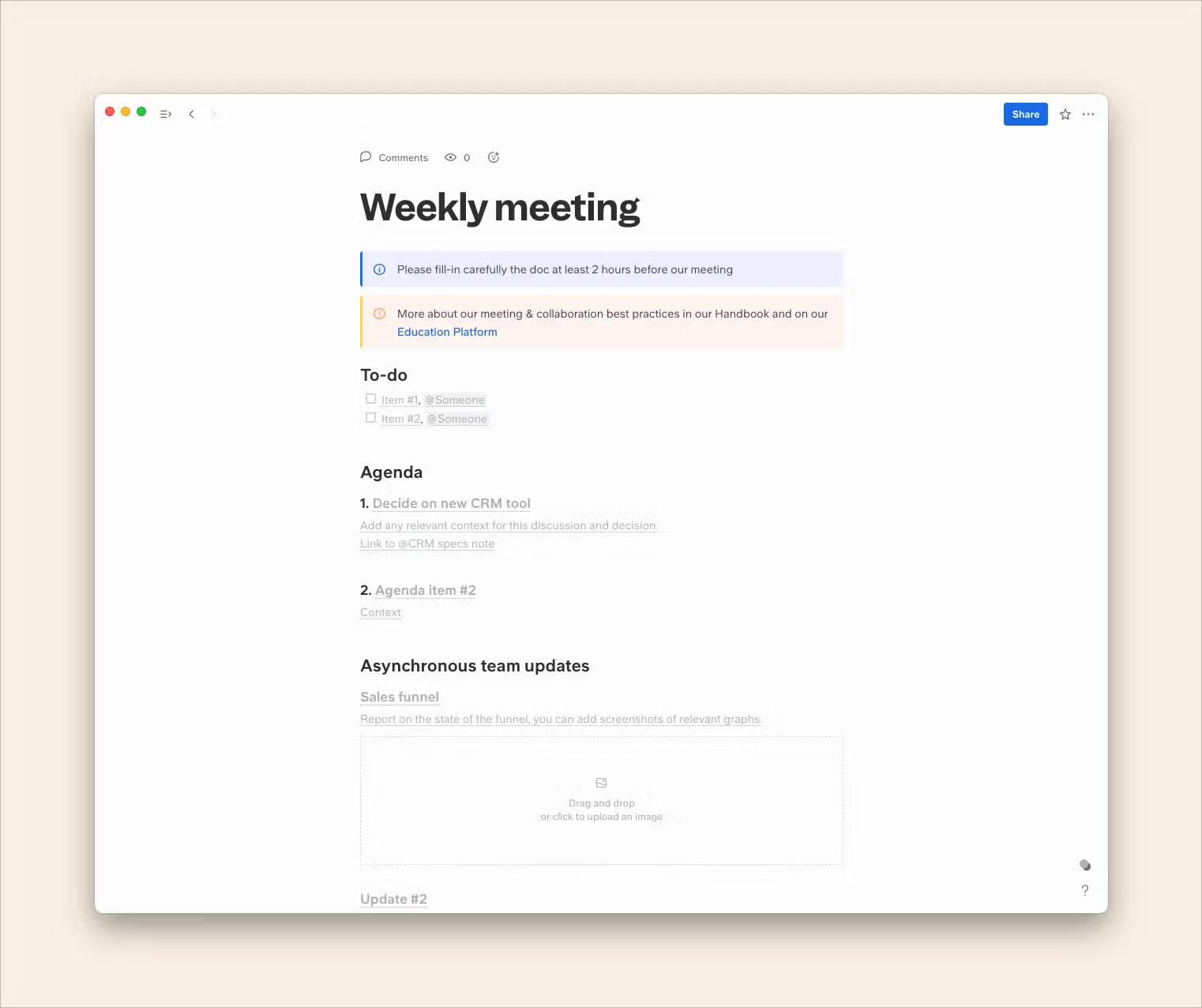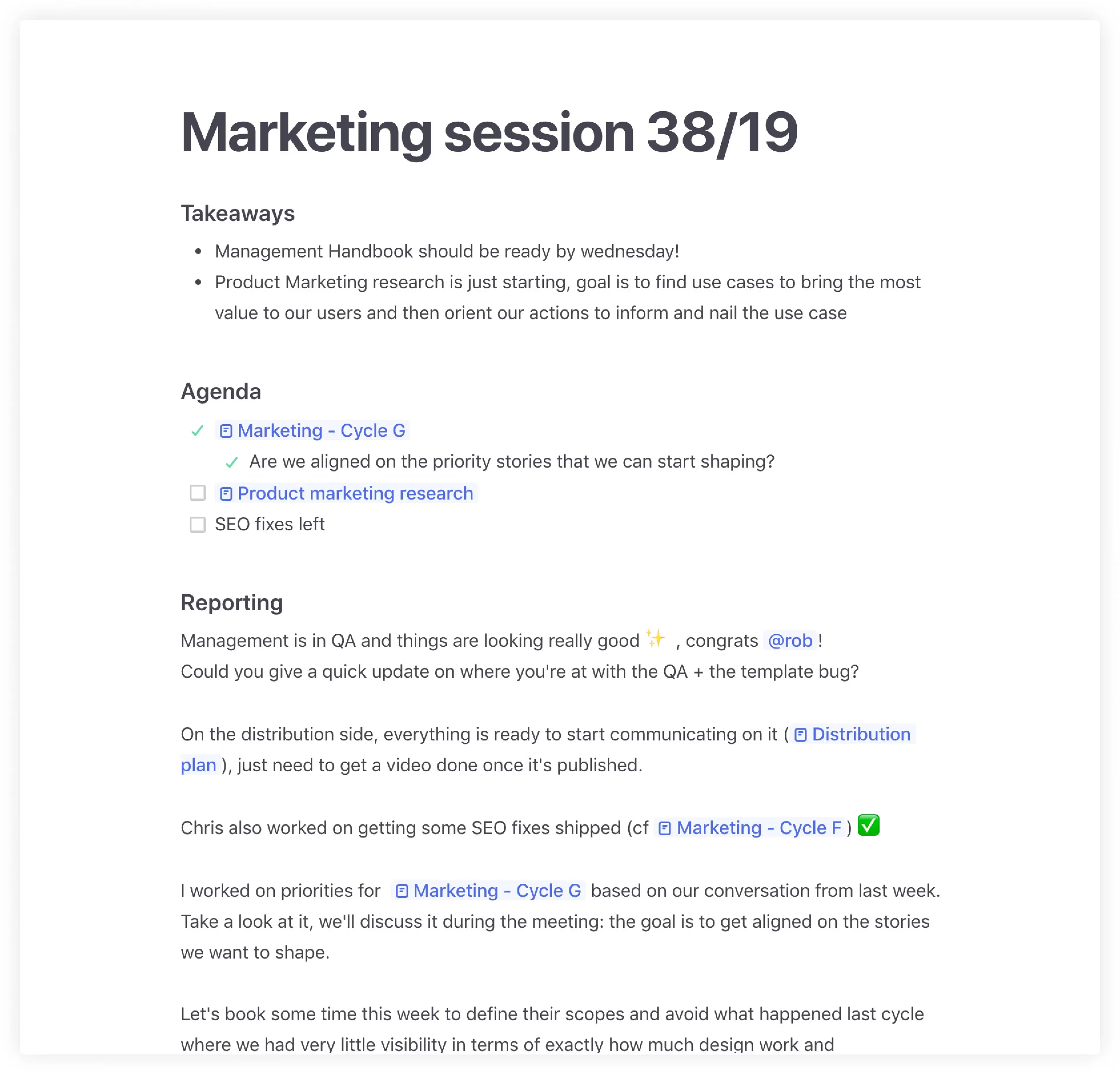Prepare a meeting agenda in advance
The agenda is probably the most overlooked and crucial part of a meeting.
Do you know that feeling, when you don't know the goal of a meeting and when the discussion gets off-topic? Blame the agenda.

The most effective agendas have few topics and are set with a realistic amount of time for each agenda item.
As much as possible, collaborate on the agenda with other participants: ask them for input on it. Once prepared, share the agenda in advance. And explicitly go through the agenda items at the beginning of the meeting.
It will give a chance for everyone to come prepared and be more focus and relevant during the meeting.
Your team meeting agenda should include for the least:
- Meeting time (start and end time)
- Attendees
- Purpose of the meeting
- Clear agenda items with objectives
Last but not least, leave some room for open discussion/impro. Include it in the agenda items at the end. It'll help you capture any open questions and include them in follow-up tasks.
For the preparation part, you should ease your task with collaborative tools, such as Slite, which helps you run great team meetings.

Related content:
Identify a meeting owner
You must identify one meeting owner.
This person is not the "team leader" but most often the one calling for the meeting. S.he should be in charge of the agenda and timing during the meeting but doesn't have to handle everything. Other persons can write meeting minutes, for instance.
For weekly team meetings, it's a good practice to rotate the meeting leader so that everyone can learn and participate actively in improving the meeting preparation and, thus, outcomes.
Meeting are work sessions, not reporting
Have you ever been involved in a weekly meeting, held for the sole purpose of sharing information? Yes (we know).
A golden rule we apply at Slite:
meetings must be dedicated to collaboration and work, not reporting.
Reporting, sharing information should be done before the meeting so everyone can reflect on it and bring solutions and questions.
So next time you want to schedule a meeting, ask yourself:
- Do I need to share information, or do I need a collaborative work session on a specific item?
- Could this item be resolved over Slack, emails, or any other asynchronous communication tool?
It will help you save time with fewer and more productive meetings.
Here is an example of a doc we share in advance. The reporting is included for support, the meeting isn't about it (check the agenda).

Cut down on attendees
The fewer, the better. Only invite people relevant to the agenda items, not the entire team.
It will avoid the discussion to drift-off. Furthermore, your decision-making process will be more focused and relevant.
And you can always share the meeting minutes asynchronously with other people if needed.
One last thing, while some say you should never bring more than seven people to a meeting, we at Slite try to reduce meetings to 3 people, as much as possible.
It is the ideal number to be sure you don't have two groups forming in parallel, which leads to information asymmetry between the participants, and people catching up during or after the meeting.
Always be on time
Sticking to the time you set for the meeting will help everyone to focus on relevant matters and cut through the noise. If anything else is left to be discussed, it can always be done in the next meeting.
Few tips to be on time:
- Have a timed-frame agenda prepared (see the previous point).
- Be explicit with your team members about it at the beginning.
- Figure out the technology in advance.
- Start with critical topics first, so you don't leave the most important ones on the table.
It's a habit to form within your team communication. The worse that can happen, as you show care for people's time, is everyone thanking you. True story.
Create accountability
To leverage your team meetings, define for each action item, a clear owner, accountable for it.
The meeting minutes should contain that information that you can share after the meeting with every participant.
The best way is to store your meeting notes in an easy to access online place so everyone can easily consult them and follow-up on their tasks. You can simplify this process by using an AI meeting assistant that automatically captures key discussion points, action items, and organizes them into structured notes.
Related content: discover how to run effective meetings with Slite
Set up the right environment
Consider if the meeting needs to be in person or not. Are there any remote team members that will need to join? If yes, make it friendly: everyone can participate remotely from their desk by using a video call conference tool such as Zoom. You'll have better-balanced participation with everyone using the same medium for communication.
For in-person meetings, laptops and phones shouldn't be present unless necessary (for instance, for the one taking the meeting notes). It will help everyone being more present, not distracting each other by browsing their emails or preparing their next slide deck.
Related content: keys principle for remote teams, discover how to run effective meetings with Slite
Get feedback to improve
All of the previous points are general guidelines proven to be effective. Depending on your context, you might need to adapt them and iterate.
Check-in with other participants to get their feelings about your team meetings and gets their inputs.
You can directly ask them questions like:
- Was there the right team members attending?
- Were the meeting's purpose, agenda items, and outcomes clear and bringing value?
- Should we adjust the time, length, frequency of the meeting?
Based on your team feedbacks, you can go through the previous points and see how to make them even more useful for your case.
Easily run productive team meetings with Slite
Productive and effective team meetings are not only good meeting minutes: you'll need to ensure that the right people have access to the right knowledge before, during and after your meetings and can easily collaborate on it.
Slite will help you make your team meetings better:
- Save time on team meeting preparation. Prepare your own meeting templates and start taking beautiful notes in seconds.
- Collaborate in real-time. Every member of your team or external contributors can edit or comment on the same document automatically sync in real-time.
- Share documents in seconds. Decide who can access them, share it through email, slack or attach it to a calendar event on the fly.
- Organize and centralize your team meeting documentation. Slite provides a powerful yet simple workspace to act as a single source of truth for your team.

